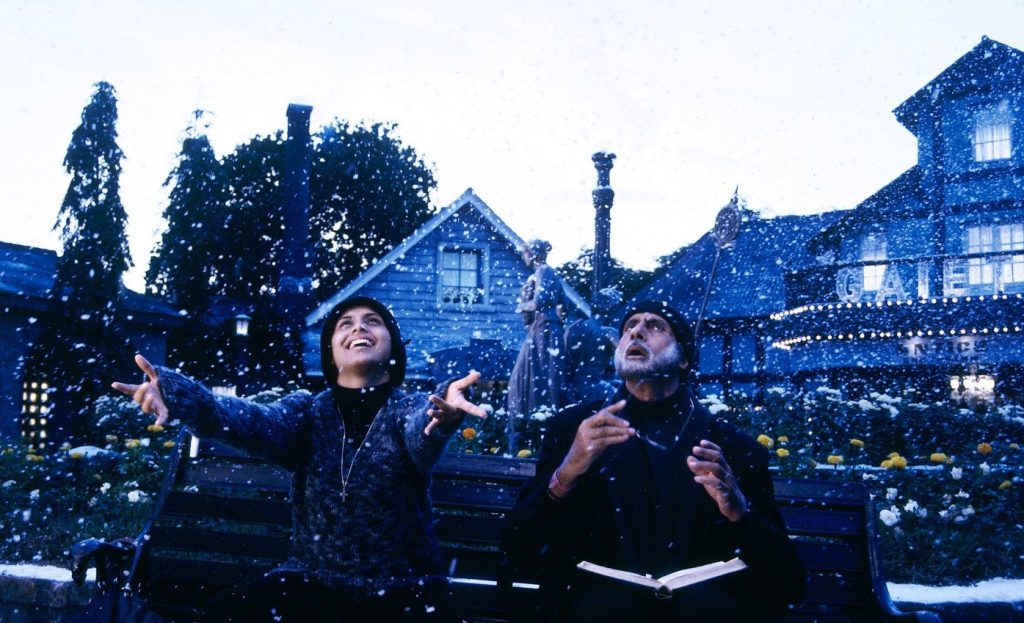When you exit a screening of Black, you can’t help but think that here is a film that forcefully reiterates Indian cinema’s second coming. Even though 2004 was a disappointing year overall for the industry, 2005 seems to have started on the right note. That note is Black. And Indian cinema, despite the occasional derailing (Kisna!), seems to be on the right track to establish itself at world level. The ideas are contemporary, the talent evident, and the technique world-class. Kudos to Sanjay Leela Bhansali.
The two tremendously talented actresses who play Michelle McNally, the protagonist whose black life the film brings to light, come from very different backgrounds. As a child, Michelle is played by Ayesha Kapur, someone who claims never to have seen an Indian film before, let alone have any kind of acting experience or training. How she pulls off such a convincing performance at such a young age is impossible to fathom. She remains an unforgettable highlight of the film. Rani Mukerji plays the part from ages 20 to 40, and she too exudes a real, empathically persuasive presence.
Michelle’s ‘magician’ teacher is Amitabh Bhachchan, who claims this to be his finest hour. And when the most prolific actor of the Indian film industry makes this claim, you sit up and notice. And while there is no doubt of Bachchan’s talent – from his dramatics to his restraints, from his voice control to his body language – you can’t help but feel that it gets perhaps a bit too theatrical in the first half of the film; energy, that he seems to lose in the second half. A graph gone wrong; but perhaps not the actor’s fault?
Superb supporting performances from Shernaz Patel and Dhritiman Chatterjee as the parents, Mahabanoo Mody-Kotwal as Mrs Nair make the ensemble a treat to watch (yes, even Nandana Sen!) A film where every actor delivers!
The story is meticulously constructed and despite striking similarities to Arthur Penn’s The Miracle Worker (1962) – holds its own and is sans supernumerary ornamentation. The script tries hard to move the audience to tears, but falters and is simply not in the league of, say, a Karan Johar screenplay in this department. But there are innumerable moments of terrific cinema and the scenes with Debraj and Michelle at the dining table, the exchange between the sisters (again at the dining table), the party/song sequence, Michelle’s failure at her exams resulting in an impromptu dance, are all incredibly memorable. Yet a little more attention to detail in this department would make the film more complete. For one, the period in which the drama unfolds can only be guessed. We see Chaplin films playing in the local theater ranging from The Kid (1912) to Modern Times (1935) – yet the overall feel seems 1940s. Sarah (her sister, played by Nandana Sen) also seems one scene short in the first half; something that would flesh out the story of that track significantly. There are logic flaws too: Given the film’s bilingualism, Michelle has to cope with understanding Hindi and English; surely it was tough to teach her one language with her unique lip reading skills, but two seems impossible. Also, wouldn’t she have to go through school to get into college?
Technically, Black is a masterpiece compared to its Indian contemporaries. The cinematography is a pleasure to behold. It seems that Ravi K Chandran and Bhansali have made the best possible choices for nearly every single frame in the film. This is well complimented with the Omung Kumar’s art direction as Bhansali marvelously restrains himself compared to his last film, Devdas; gone is the in-your-face-opulence and replaced with cool tones – black, blues, browns for the highly stylized lighting and art. Instead of the garish sets, we see more realistic spaces that only occasionally overcome the central characters. And the attention to detail is marvelous: Bhansali paints in the corners.
Resul Pookutty’s on-location sync sound recording matches any Hollywood film. This film alone should be the reason why on-location sound should become the rule rather than the exception in Bollywood. It lifts performances and makes every scene more tactile. It’s time to let go of the ADR legacy. The background music punctuates the film well, however, it is scored only to be a foil for the picture and doesn’t have a character of its own. The editing is crisp and without flaws, with an aesthetic in place for the painstaking color correction.
Black is essentially a small film. And while it maybe compared to the good contemporary Hollywood films in its category, it cannot be considered an Indian classic on grounds of its canvas alone. A crowning glory for Sanjay Leela Bhansali for sure, he has fine-tuned his craft with lessons learnt from his earlier efforts. He has managed to raise the bar considerably for other filmmakers in his class… it’s a good time for Indian cinema.
English, Hindi, Drama, Color
https://www.youtube.com/watch?v=dbq-NQohIAc


